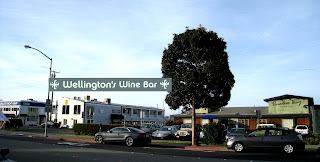 Yesterday afternoon Alex and I met up and caught the ferry to Sausalito from San Francisco. It was a beautiful afternoon and we enjoyed a couple of Lagunitas Pale Ales on the upper deck of the Sonoma during the ride across the Bay.
Yesterday afternoon Alex and I met up and caught the ferry to Sausalito from San Francisco. It was a beautiful afternoon and we enjoyed a couple of Lagunitas Pale Ales on the upper deck of the Sonoma during the ride across the Bay. Since Cass was meeting us at our place a little later, we decided to stop off at Wellington’s Wine Bar on our way home.
Since Cass was meeting us at our place a little later, we decided to stop off at Wellington’s Wine Bar on our way home. As you would expect for a Friday afternoon, Wellington’s was busy, but we were able to get a table inside. Here is a shot taken from our table, and a video taken from outside on Wellington’s deck.

It just does not get any better than hanging out with one's son (at least one of them – Andrew, Rob and Pat, wish you had been there too!) in a pub at the end of the week on a Spring afternoon.
Wellington’s opened a couple of years ago and ever since it has become one of our favorite places to go for a drink, including on special occasions - it was our family’s initial stop for both my and Nancy’s 60th birthday parties.
 Wellington’s is very much a relaxed, neighborhood place as suggested by its location outside of Sausalito’s main tourist area. They have a very friendly staff led by the proprietor, Jeremy John, who is originally from London where his parents were publicans.
Wellington’s is very much a relaxed, neighborhood place as suggested by its location outside of Sausalito’s main tourist area. They have a very friendly staff led by the proprietor, Jeremy John, who is originally from London where his parents were publicans.
Wellington’s name also reflects Jeremy’s roots as indicated on their website and by the footwear on the back wall:
“The Wellington boot, also known as the "Wellie," is a type of boot popularized by Arthur Wellesley, the first Duke of Wellington. The boot became immediately fashionable among the British aristocracy in the early 19th century, and, to this day, has maintained its popularity by becoming required footwear for any Brit taking a stroll through the countryside. As any good Englishman will tell you, one's Wellies have two principal uses: the first is to wear them when walking one's dog across England's glorious pastures green; and the second is to wear them when heading towards the local watering hole for a drink.”

Wellington’s focuses on wine and that is what we normally have there. In fact through their wide-ranging wines by the glass program, Wellington’s has introduced us to some of our favorite wines, such as, just about the same time last year, Allimant Laugner’s fabulous Cremant d’Alsace Sparkling Rosé which has been our go-to drink ever since.
However, yesterday since Alex and I had started with beer on the ferry, we asked Jeremy what he would recommend from their beer menu. He said that they just started offering an excellent British ale called Wells Bombardier, so Alex and I requested a couple of pints:

As described on the bottle:
“Wells Bombardier English Premium Ale is an award winning traditional English Ale, which is noted for its distinctive copper colour. It has a rich and tempting aroma of peppery hops and raisins, while the palate is dominated by more dark fruit, juicy malt and tangy hop.”Both Alex and I really enjoyed the beer, and the heft and shape of the bottle, and the label (including the red Cross of St. George), were distinctive and attractive. I also discovered through some later research on the company website that they have a very whimsical and appealing ad program.
 Jeremy told us that Wellington’s will be celebrating St. George’s Day (St. George being the patron saint of England and no friend of dragons) on April 23.
Jeremy told us that Wellington’s will be celebrating St. George’s Day (St. George being the patron saint of England and no friend of dragons) on April 23. According to Jeremy, Wells Bombardier will be the featured beverage that day, along with porchetta from CIBO across Bridgeway from Wellington’s.
According to Jeremy, Wells Bombardier will be the featured beverage that day, along with porchetta from CIBO across Bridgeway from Wellington’s. We’ll be back for that event, but between now and then I will have to see if I can find myself an official Wells Bombardier St. George jester’s hat for the occasion (did I mention Wells Bombardier's whimsical side?).
We’ll be back for that event, but between now and then I will have to see if I can find myself an official Wells Bombardier St. George jester’s hat for the occasion (did I mention Wells Bombardier's whimsical side?). For any who do not know Wellington’s, it is quite easy to find, and is only about a 10-minute walk north from the ferry dock. See the below map and photo.
For any who do not know Wellington’s, it is quite easy to find, and is only about a 10-minute walk north from the ferry dock. See the below map and photo.
 It is well worth a visit. Just please don’t take our seats!
It is well worth a visit. Just please don’t take our seats!


















































